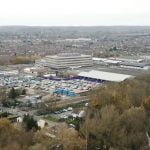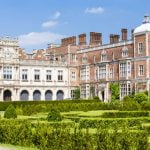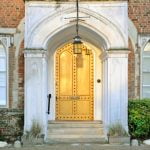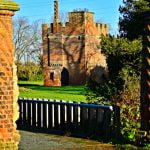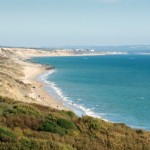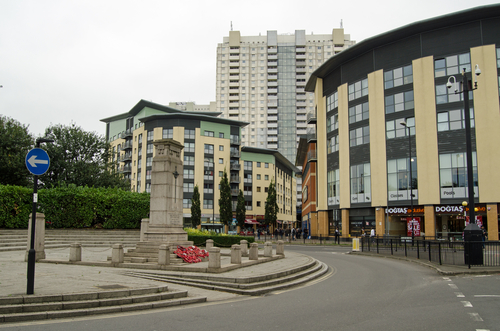
The London Borough of Enfield is the most northerly district of the Greater London Area. The borough was created in 1965 from the merger of the Municipal Boroughs of Southgate, Enfield and Edmonton. It borders the London Boroughs of Barnet to the west, Haringey to the south and Waltham Forest to the southeast, and the districts of Hertsmere to the northwest, Welwyn Hatfield and Broxbourne to the north, and Epping Forest to the east. Enfield is perhaps best known for being home to the Royal Small Arms Factory (closed 1988) that produced the Lee Enfield rifle. The borough has an area of 81 square km, and at the 2011 UK Census, a population of 312,466 was recorded.
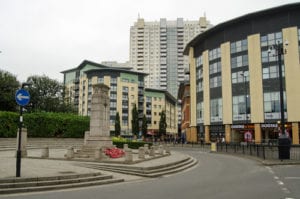
Downtown Edmonton in the Borough of Enfield Editorial credit: BasPhoto / Shutterstock.com
A Very Brief History
Archaeological evidence suggests that the first settlers of the Enfield area were the Romans, who built settlements in the areas of Edmonton and Bush Hill Park. The Romans would certainly active in the area, as their strategically important thoroughfare of Ermine Street, which linked Londinium and York, ran through the borough.
In AD 790, King Offa of Mercia bequeathed the land around Edmonton to St Albans Abbey. The area became strategically important only a few years later when East Anglia was invaded by the Danes. The area was fortified by King Alfred the Great in order to keep the Danes to the east of the River Lea.
By the 11th Century, Enfield Town, the largest settlement in the parish, was an administrative and religious centre. At the time of the Domesday (1086), Enfield was recorded as having a priest. The town’s church is thought to have been on the current site of St Andrews Church.
Throughout the 13th century, Enfield Town continued to dominate as the area’s main centre of commerce. At the beginning of 14th Century, Edward I granted Humphrey de Bohun, the Lord of the Manor of Enfield, a market charter giving him the right to hold a weekly market and two annual fairs in the town. Towards the end of the century, the Black Death struck much of the country for the first time, which struck down more than 10% of the local population around Enfield.
By the 15th Century, a number of small hamlets were beginning to develop in the locality of the Enfield area. Southgate and Edmonton became particularly prominent, with the latter seeing the All Saints Church built in Church Street. However, the vast majority of the borough was still covered in woodland and oak forests.
It was during the 16th Century that the borough became a favoured hunting ground of the Royals. Henry VIII commissioned the building of Elsyng Palace, which remained a favourite of Elizabeth I, who stayed there frequently between 1564 and 1572.
In the early 17th Century, it was recognised that clean water needed to be delivered to London to facilitate the rapidly growing population. In a major feat of engineering, a 40-mile (64 km) canal was built between Ware in present-day Hertfordshire and north London. Passing through Enfield, the canal was dubbed the ‘New River’ and is still in existence today.
Lee Enfield
During the 18th and 19th centuries Enfield’s urbanization continued at pace, with the increasing wealth of its residents, the buildings in the area became more and more grandiose. With the railways came Enfield’s significant contribution to industry and science. In 1814, the Royal Small Arms Factory was opened in Enfield. In 1895, the factory began the manufacture of the famed Lee Enfield Rifle, invented by James Paris Lee. Later the factory produced both the Sten submachine gun and the Bren light machine gun, which played a vital role in the WW2 war effort and later post-war conflicts.
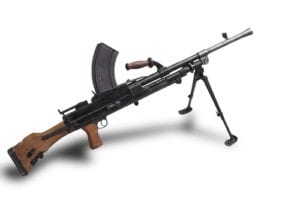
Sten submachine – was manufactured in Enfield
By the mid-19th century, Enfield had become synonymous with the service industries as both gas and water companies had set up in the borough by that time. The coming of the railway in 1840 helped to promote the area as an industrial base. By the end of the century, brickmaking and light bulb production had also become important to the local economy. The turn of the Century saw local industry in the borough continue to grow rapidly. Along with the expansion of industry, came rapid population growth. While in 1891, the borough’s inhabitants had numbered 68,557; by 1911 the population had grown to 154,907.
The borough has a strong association with 20th Century innovation as it is where John Ambrose Fleming invented the diode valve and Charles Belling came up with the infrared fire bar. Enfield produced the first BBC transmitters and also was the leader in manufacturing breakthrough household goods such as colour TVs and dishwashers. The borough was home to the major brand names that were instrumental in the dramatic rise of the mid-20th-century white goods industry, like Ferguson, Hotpoint, EMI and Thorn. Their factories were mostly clustered around the Great Cambridge Road. However, like much of the rest of the UK, the borough’s manufacturing base has now fallen into serious decline. The local council are currently in the process of trying to implement measures to bring back industry and new create jobs.
The Borough of Enfield is currently twinned with: Courbevoie, Hauts-de-Seine, France; Halandri, Greece; Sariyer, Turkey; Schwechat, Lower Austria, Austria; and the German areas of Wandlitz, Brandenburg, Gladbeck; North Rhine-Westphalia and Freudenstadt, Baden-Württemberg.
Getting around!
In general, it’s often cheaper and more convenient to get around London by public transport rather than by car, due to additional road charges and difficulties in parking.
Road
The main roads running through the borough include the North Circular Road, the orbital M25, Green Lanes, the A10, the old Hertford Road (A1010) and the A406 outer orbital link road. Alon There is also numerous bus services throughout the borough run by Transport for London.
Train
The Borough of Enfield is served by the Piccadilly line of the London Underground, the London Overground and National Railway services. Train stations are located as follows:
London Overground Stations
- Silver Street
- Edmonton Green
- Bush Mill Park
- Enfield Town
- Southbury
- Turkey Street
Underground (Tube) Stations
- Arnos Grove
- Southgate
- Oakwood
- Cockfosters
National Railway Stations
- Edmonton Green
- Enfield Chase
- Enfield Lock
- Ponders End
Famous People
Famous people who were born, have lived, or who are living in the London Borough of Enfield, include;
- Adele (b. 1988) – Contemporary world-renowned singer/songwriter
- Joseph Bazalgette (1819–1891) – Victorian civil engineer who designed much of London’s early sewerage system
- Bernard Bresslaw (1934–1993) – comic actor, best remembered for his roles in the ‘Carry On’ films
- Benjamin Disraeli (1804–1881) – politician, distinguished prime minister and novelist
- Bruce Forsyth (1928–2017) – TV personality, presenter, actor, comedian, singer, dancer, and screenwriter whose career spanned more than 70 years.
- Boris Karloff (1887 – 1969) – English actor, primarily known for his roles in horror films, especially those of Frankenstein’s monster
- John Keats (1795 1821) – Renowned 2nd generation English Romantic poet
- William Pitt, (1708–1778) – Earl of Chatham, British Prime Minister and statesman
- Amy Winehouse (1983–2011) – Contemporary world-renowned singer/songwriter
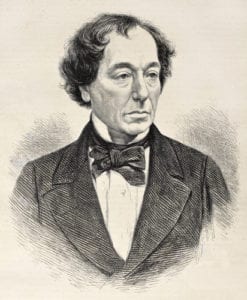
Renowned Victorian Prime Minister Benjamin Disraeli once lived in the Borough of Enfield
Did you know?
- The Lee Enfield rifle was standard issue in the British Army between 1895 and 1957
- The 15th Century Rose & Crown Pub in Enfield was once owned by notorious highwayman Dick Turpin’s Grandfather
- The world’s first ATM went in operation in June 1967 at the Enfield branch of Barclay’s Bank
Things to see and do!
Enfield is particularly known for its wealth of open spaces. Some of its main parks and green spaces, along with its top attractions, are listed below:
Parks and open spaces
- Lee Valley Regional Park – Open space with sports venues, comprising a 40 km (26 miles) of paths and 4,000-hectare park.
- Trent Park – Vast parkland space which was once a royal hunting ground, now used for leisure activities.
- Epping Forest – Sprawling woodland with over 1600-hectare of old-growth forest, walking trails, rivers & ponds.
- Broomfield Park – 21-hectare of public park in Palmers Green.
- Walthamstow Wetlands – Urban nature reserve comprising 10 reservoirs, with birdwatching, cafe & visitors centre.
- New River – 64 km (40 miles) of ancient canal and reservoir, opened in 1613.
- Hatfield Forest – Vast parkland with ancient royal hunting grounds with paths and forest walk and 1200-year-old trees.
- Harlow Town Park – 66-hectare park featuring a bandstand, paddling pool, skate park & gardens.
Tourist attractions
- Forty Hall – Historic stately home museum & extensive grounds.
- Myddelton House Gardens – Restored botanical gardens, carp lake, Victorian glasshouse, visitor’s centre, museum and cafe.
- Paradise Wildlife Park – Family zoo providing exotic wildlife & animal experience.
- William Morris Gallery – Georgian house set in parkland, celebrating the work of the famed arts and crafts designer.
- Lee Valley White Water Centre – Large, man-made white water adventure complex with a lake
- Royal Gunpowder Mills – Industrial museum and heritage centre, set in 70-hectare of parkland, at Waltham Abbey.
- Whitewebb’s Museum of Transport – Features historic cars, motorcycles & related memorabilia, plus model railway display.
- Henry Moore Foundation – Studios, gardens, sculptures and art museum.
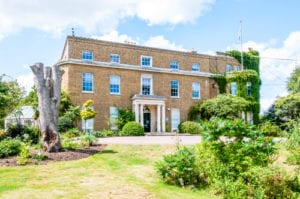
Myddleton House Gardens in the Lee Valley Regional Park Editorial Credit: Abdul Shakoor/ Shutterstock.com
Where To Stay In Enfield
There is some choice of hostel-style accommodation, with basic facilities, in or close to the Borough of Enfield. There’s also plenty of B & B/Guesthouse/Travel Lodge style accommodation on offer. If you’re looking for a bit more luxury then there’s also plenty 3 and 4 hotel-style accommodation. When it comes to price Enfield is definitely at the low end of the spectrum, when looking across the Greater London Area as a whole. Available apartments tend to cater for between 2 and 6 people. They can often work out cheaper than hotels for larger parties but there is often great differences in standards. Indicative prices for the most readily available types of accommodation/per night, based on 2 adults sharing, unless otherwise indicated, are as follows:
Hostel: £30 – £40 (1 or 2 people sharing)
B & B/Guesthouse/Travel Lodge: £50 – £80
3/4 Star Hotel: £80 – £150
Apartments vary greatly based on no. of available berths, location and standard
If you enjoyed this London guide, check out some of our other London guides by clicking the link below.
